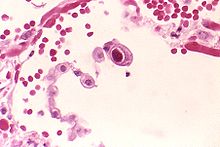Betaherpesvirinae is a subfamily of viruses in the order Herpesvirales and in the family Herpesviridae. Mammals serve as natural hosts. There are 26 species in this subfamily, divided among 5 genera. Diseases associated with this subfamily include: human cytomegalovirus (HHV-5): congenital CMV infection; HHV-6: 'sixth disease' (also known as roseola infantum or exanthem subitum); HHV-7: symptoms analogous to the 'sixth disease'.[1][2]
| Betaherpesvirinae | |
|---|---|

| |
| Cytomegalovirus infection of a pneumocyte | |
| Virus classification | |
| (unranked): | Virus |
| Realm: | Duplodnaviria |
| Kingdom: | Heunggongvirae |
| Phylum: | Peploviricota |
| Class: | Herviviricetes |
| Order: | Herpesvirales |
| Family: | Orthoherpesviridae |
| Subfamily: | Betaherpesvirinae |
| Genera | |
|
See text | |
Genera
editBetaherpesvirinae consists of the following five genera:[2]
Structure
editViruses in Betaherpesvirinae are enveloped, with icosahedral, spherical to pleomorphic, and Round geometries, and T=16 symmetry. The diameter is around 150-200 nm. Genomes are linear and non-segmented, around 140-240kb in length.[1]
| Genus | Structure | Symmetry | Capsid | Genomic arrangement | Genomic segmentation |
|---|---|---|---|---|---|
| Roseolovirus | Spherical pleomorphic | T=16 | Enveloped | Linear | Monopartite |
| Cytomegalovirus | Spherical pleomorphic | T=16 | Enveloped | Linear | Monopartite |
| Proboscivirus | Spherical pleomorphic | T=16 | Enveloped | Linear | Monopartite |
| Muromegalovirus | Spherical pleomorphic | T=16 | Enveloped | Linear | Monopartite |
Life cycle
editViral replication is nuclear, and is lysogenic. Entry into the host cell is achieved by attachment of the viral glycoproteins to host receptors, which mediates endocytosis. Replication follows the dsDNA bidirectional replication model. DNA templated transcription, with some alternative splicing mechanism is the method of transcription. Translation takes place by leaky scanning. The virus exits the host cell by nuclear egress and budding. Betaherpesviruses typically have highly restricted host ranges, although essentially all mammals, reptiles, and birds are infected with at least one betaherpesvirus species. Transmission routes are transplacental, transplantation, blood transfusion, body fluids, urine, and saliva.[1]
Betaherpesvirinae establish latency (site where virus lies dormant until reactivated) in CD34+ myeloid progenitor cells and CD14+ monocytes.[3] This is different from Alphaherpesvirinae, which establish latency in neurons, and Gammaherpesvirinae, which establish latency in memory B cells.[3]
| Genus | Host details | Tissue tropism | Entry details | Release details | Replication site | Assembly site | Transmission |
|---|---|---|---|---|---|---|---|
| Roseolovirus | Humans | T-cells; B-cells; NK-cell; monocytes; macrophages; epithelial | Glycoproteins | Budding | Nucleus | Nucleus | Respiratory contact |
| Cytomegalovirus | Humans; monkeys | Epithelial mucosa | Glycoproteins | Budding | Nucleus | Nucleus | Urine; saliva |
| Proboscivirus | Elephants | None | Glycoproteins | Budding | Nucleus | Nucleus | Contact |
| Muromegalovirus | Rodents | Salivary glands | Glycoproteins | Budding | Nucleus | Nucleus | Contact |
Human health
editThere are four known member species of the Betaherpesvirinae subfamily that are infectious for humans:
- Human cytomegalovirus (HCMV), also known as Human herpesvirus 5 (HHV-5),
- Human herpesvirus 6A and 6B (HHV-6A and HHV-6B), which were classified as distinct species in 2012,[4]
- Human herpesvirus 7 (HHV-7)
Human cytomegalovirus (HCMV, HHV-5) "seems to have a large impact on immune parameters in later life and may contribute to increased morbidity and eventual mortality."[5] Human herpesvirus 6A (HHV-6A) has been described as more neurovirulent,[6] and as such is more frequently found in patients with neuroinflammatory diseases such as multiple sclerosis.[7] Both human herpesvirus 6B (HHV-6B) and human herpesvirus 7 (HHV-7), as well as other viruses, can cause a skin condition in infants known as exanthema subitum, roseola infantum (rose rash of infants) or the sixth disease.
References
edit- ^ a b c "Viral Zone". ExPASy. Retrieved 12 June 2015.
- ^ a b "Virus Taxonomy: 2020 Release". International Committee on Taxonomy of Viruses (ICTV). March 2021. Retrieved 10 May 2021.
- ^ a b Cohen, Jeffrey I. (1 July 2020). "Herpesvirus latency". The Journal of Clinical Investigation. 130 (7): 3361–3369. doi:10.1172/JCI136225. ISSN 0021-9738. PMC 7324166. PMID 32364538.
- ^ Adams, M. J.; Carstens, E. B. (2012). "Ratification vote on taxonomic proposals to the International Committee on Taxonomy of Viruses (2012)". Archives of Virology. 157 (7): 1411–22. doi:10.1007/s00705-012-1299-6. PMC 7086667. PMID 22481600.
- ^ Caruso, Calogero; Buffa, Silvio; Candore, Giuseppina; Colonna-Romano, Giuseppina; Dunn-Walters, Deborah; Kipling, David; Pawelec, Graham (2009). "Mechanisms of immunosenescence". Immunity & Ageing. 6: 10. doi:10.1186/1742-4933-6-10. PMC 2723084. PMID 19624841.
- ^ De Bolle, L.; Van Loon, J.; De Clercq, E.; Naesens, Lieve (2005). "Quantitative analysis of human herpesvirus 6 cell tropism". Journal of Medical Virology. 75 (1): 76–85. doi:10.1002/jmv.20240. PMID 15543581. S2CID 31720143.
- ^ Álvarez-Lafuente, Roberto; García-Montojo, Marta; De Las Heras, Virginia; Bartolomé, Manuel; Arroyo, Rafael (2006). "Clinical parameters and HHV-6 active replication in relapsing—remitting multiple sclerosis patients". Journal of Clinical Virology. 37: S24–6. doi:10.1016/S1386-6532(06)70007-5. PMID 17276363.
External links
edit- Betaherpesvirinae at the U.S. National Library of Medicine Medical Subject Headings (MeSH)
- Viralzone: Betaherpesvirinae
- ICTV